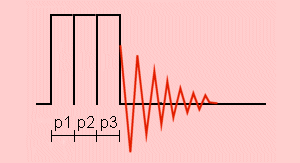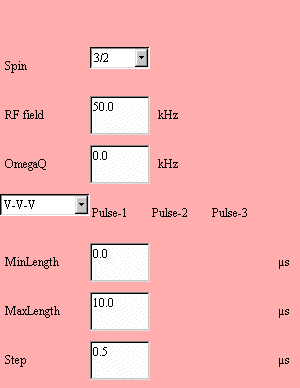AIM: Determination of the quadrupole coupling from a featureless NMR lineshape
Launch the ringing-pulse applet with Java Web Start.

When we apply the one-pulse sequence to quadrupole spins with low gyromagnetic ratio, spurious signals that distort the base line of the NMR spectrum are observed. The composite-pulse sequence, introduced by M. Mehring's group, cancels these spurious signals. There are three RF pulses in this sequence. As a result, there is no excitation condition of the quadrupole spins that allows us to quantify the number of spins in the crystal. Furthermore, the acquisition delay or the "dead time" of the NMR probe head modifies the line intensity. However, the "dead time" necessary for this sequence is four times smaller than that for the one-pulse sequence.

The left part of the simulation panel indicates the physical parameters. It is preset for a typical experiment on a spin I = 3/2. You can introduce your own values.
There are seven ways to apply this composite-pulse sequence. Therefore, we have to select one with the lower choice box. For example, the left-hand side V in V-V-V means p1 is variable, the central V in V-V-V means p2 is variable, and the right-hand side V in V-V-V means p3 is variable. That is, the three parameters (MinLength, MaxLength, and Step) are identical for the three pulses. Similarly F means fixed for the corresponding pulse length.
For simplicity, when two or three pulse-lengths are variable, only the parameters concerning the first variable pulse are given.
When a pulse length is constant, it should be provided in the MinLength field.
MinLength: the first variable pulse-length in µs
MaxLength: the last variable pulse-length in µs
Step: the increment of the variable pulse-length in µs
Since the composite-pulse program for Bruker MSL spectrometer is provided in this site, here only the RF pulse phases and the receiver phases are given:
First pulse : -X -X +X +X
Second pulse : +X +X +X +X
Third pulse : +X -X -X +X
Receiver phase: +y -y +y -y
The following applet is initialized for the central-line intensity of a spin I = 3/2 in a single crystal excited by the composite-pulse. The three pulse-lengths vary simultaneously and in the same way (V-V-V). The experimental line intensities are identical to the simulated ones.
Help for selecting all the simulated data of the line intensity text area in a JDK1.1.8 applet.
